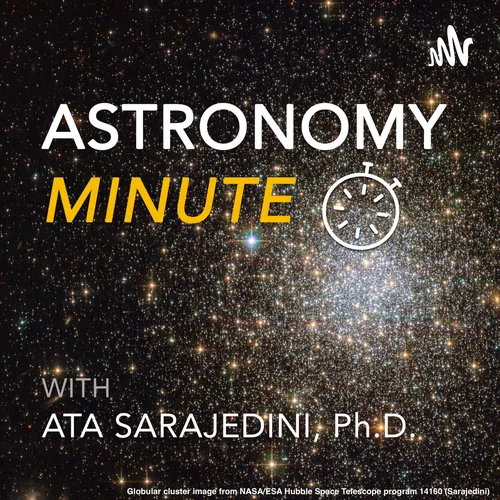
Astronomy Minute
Learn the basics of astronomy in one-to-two minute packets of concise information about specific topics. You are a busy person with a short attention span, and you want to learn about astronomical topics in a short amount of time. Your host Professor Ata is a PhD research astronomer and astrophysicist and a noted authority on stellar and galactic astronomy. I welcome your feedback at [email protected]. See the web site astronomyminute.org for more. The podcast logo is courtesy of Zachary Greathouse and shows a globular cluster photo taken by the author with the Hubble Space Telescope.
- Update frequency
- every 3 days
- Average duration
- 1 minutes
- Episodes
- 183
- Years Active
- 2020 - 2023

Which Notable Objects are in the Constellation of Andromeda?
A brief description of the notable celestial objects located in the constellation of Andromeda.

What is Meant by a Deep Sky Object?
A brief description of what is meant when astronomers refer to something as a deep sky object?

What is an Asterism?
A brief description of how we define an asterism in the sky as distinct from a constellation.

Why do We Study Astronomy?
A brief description of why we study the nature of the Universe. We are mainly interested in gaining knowledge about the universe for the sake of the knowledge itself.

The Universe as a Time Machine
A brief description of how the finite speed of light can be used to our advantage - allowing us to look back in time to see the history of the Universe.

How Old is the Universe, the Sun, and the Earth?
A brief description of how old the universe is as compared with the ages of the Sun, the Earth, and how long Homo Sapiens have lived on the Earth.

What is a Light Year?
A brief description of a light year - a unit of distance based on how far light travels in one Earth year.

What is Electromagnetic Radiation?
A brief description of electromagnetic radiation - that is to say light - and how its wavelength, frequency, and energy are related.

What is Meant by the Hubble Flow?
A brief description of the term Hubble Flow in astronomy. The universe is expanding on the largest scales, and this large-scale expansion of the Universe is known as the Hubble Flow.

What is a Blackbody Curve or Planck Curve?
A brief description of Blackbody or Planck curves. In short, these curves tell us the brightness of stars of a certain temperature.

What is Precession of the Equinoxes?
A brief description of the phenomenon known as Precession of the Equinoxes.

What is Meant by the Signs of the Zodiac?
A brief explanation of the zodiac and how it relates to the other constellations in the sky.

Is There Life Elsewhere in the Universe?
A brief order-of-magnitude description of the probability of life elsewhere in the universe beyond earth.

How Old is the Solar System?
A brief description of two independent methods that give an age of 4.5 billion years old for the Solar System.

How Did Our Galaxy Form?
A brief description of how we think the Milky Way galaxy formed. Basically, it's a process whereby hundreds to thousands of low-mass dwarf galaxies collided and coalesced to form our our galaxy.

Is There Such a Thing as THE Dark Side of the Moon?
A brief description of why there is no such thing as the dark side of the Moon.

What is Meant by Taxonomy in Science?
A brief description of taxonomy in science and how it is used to classify objects that are similar to each other.

What are the Magellanic Clouds?
A brief description of two dwarf galaxies known as the Large and Small Magellanic Clouds that are in orbit around own Milky Way galaxy .

What do I Need to Know About Isaac Newton?
A brief description of Isaac Newton's contributions to science and mathematics. More information is available in the podcasts entitled “What are Newton’s Laws of Motion?” and “What is Newton’s Law of…

What do I Need to Know About Galileo?
A brief description of Galileo's contributions to astronomy.